2018 Honda CB1000R Review - First Ride
The CB750's rightful heir carries on the most honorable tradition, 49 years later
Okay so maybe I have grown a little bit jaded, ogling then hopping on all these exciting new models year after year, only to stumble across so many of them parked in the gutter a few years later with bald tires and faded paint. Like a grizzled combat veteran, you learn not to make new friends, to control your expectations. Lots of us were knocked for a loop by the Kawasaki Z900RS last year, and I was swept up in the rabble. Later, I felt the bike was a little too derivative of Kawasaki’s earlier work, too obviously grasping at middle-aged heartstrings. Ten minutes later the cool kids were slobbering all over the Vitpilen. I didn’t quite feel it, personally, and riding the bike a while ago didn’t convert me. Next.
2018 Honda CB1000R
| Engine | 17.5/20 |
| Suspension/Handling | 14.0/15 |
| Transmission/Clutch | 9.0/10 |
| Brakes | 9.0/10 |
| Instruments/Controls | 4.75/5 |
| Ergonomics/Comfort | 9.0/10 |
| Appearance/Quality | 9.75/10 |
| Desirability | 9.75/10 |
| Value | 9.0/10 |
| Overall Score | 91.75/100 |
This new Honda CB1000R, on the other hand, really grabbed me by the hips at last year’s EICMA and never let go, especially after Mick Doohan rode it onto the stage. It vaguely says Honda, but doesn’t really look like any CB that’s come before. Honda says it’s “combining sport/naked street fighter performance with minimalist cafe racer styling to create the ultimate sports roadster.” As near as I can tell, it’s the shadow cast on the cave wall by various Nortons, MV Agustas and other classic roadsters, the flickering outlines of the bikes that drove Soichiro and crew to pack up and go race the Isle of Man in 1959.
Or maybe I’m just a sucker for a seamless gas tank? This Honda’s compound-curved beauty of a glossy black tank sucks me directly in, no metal flake or coloration needed – well, there’s a little flake in the silver stripe where tank meets seat.
I guess I’m just a fan of more understated, subtle styling – and that’s what the new CB seems to be all about, from the classic round headlight to the tip of its swingarm-mounted rear fender (which allows it to dispense with the usual government-mandated rear-end scaffolding). Brushed aluminum trim and highlights brighten things just the right amount. The only cheesy piece is the cheap plastic front fender. WTH? It’s a small thing. Never mind.
The new CB’s not just a design exercise, though. While Honda was at it, they thoroughly redid the old CB. We’ve got an all-new steel monotube frame that’s supposedly stiffer even as it reduces weight by 5.5 pounds.
New die-cast aluminum side plates carry the swingarm pivot and footpegs, and linkage-free suspension works fine with a progressive-wound spring. Combined with an exhaust system that’s 10 lbs lighter, Honda puts the new bike at 18 lbs lighter than the outgoing model; the official MO scales have it at 17 lbs lighter – 468 compared to the old bike’s 485. (The missing pound or two is down to the new tank holding, according to Honda, 0.2 gallons less than the old one – now 4.3 gallons.)
New suspension? But of course. Now there’s a 43mm Showa SFF-BP (Separate Function Fork- Big Piston) fork up front, and the new shock out back serves up 5.2 inches of wheel travel – a fifth of an inch more than before. Tokico isn’t the first name you think of when it comes to brakes on a Honda, but these four-pot calipers are the same ones used on the CBR1000RR, clamping 310mm rotors under the direction of two-channel ABS.
Electrons
What with all our complaining about the old CB’s lack of TC, ABS, etc., Honda had little choice but to address those issues, which it did in a reasonably well thought-out, easy to use way.
There’s a mode button and a rocker switch on the left handlebar that lets you toggle easily through Standard, Sport, Rain and User modes – and it automatically sets Traction Control, Engine Braking and Power in each mode. Unfortunately, if you’re in STANDARD like we are in this photo, you’re only getting ⅔ power according to the pie chart graph. To get full power, Mr. Sulu, you’ll need to be in SPORT or USER modes. In USER, you can easily turn off Traction control with a dedicated button on the left switchgear, and pull lurid second-gear wheelies if you’re good at lurid second-gear wheelies.
I don’t really like my motorcycle calling me USER the whole time I’m riding it. I get enough of that at home. SPORT seems to also work fine for me, since I mostly keep my front wheel on the ground, and in any of the modes throttle response is nice and smooth 96% of the time. In real take-no-prisoners tight-road curve slaying, though, there is a bit of abruptness in 2nd gear, which is partially down to bumps in said tight corners. A 4% shortening of overall gearing really renders 1st too low for much of anything except starting from a stop, which is also easy enough in 2nd gear.
Another thing you’ll notice when taking up the cudgels to keep up with the Joneses on tight backroads is that you’ll be wanting to fan the clutch lever a bit to really motivate the CB out of slow corners, as the bump in peak horsepower didn’t do anything for lower-rpm power production. Luckily, the new slip/assist clutch is a pleasure to fan.
A higher compression ratio in the new CB1000 engine (11.6:1 vs 11.2:1), more valve lift, and bigger throttle bodies – all the way up from 36 to 44mm! – helped the new bike make four more horsepower on the dyno than the last one we tested, but torque is down a couple pound-feet, and the torque peak is now at 8300 rpm instead of 7300 as with the old engine. The dyno chart makes the situation appear worse than it feels from the saddle, probably due to the 4% overall lower gearing. By 6000 rpm, things are definitely beginning to stir, and from that point, few will complain about any lack of power. If you were waiting for the Neo Cafe to cross-shop it with the retro Kawasaki Z900RS, you’ll be happy to see the Honda outpowers the Z nearly everywhere, but it does go through a bit of a doldrum from 4000 rpm to 6000 that’s only really noticeable when you’re in a hurry on tight backroads. In normal use, you just open the throttle more and blast right through it. This one’s more roadster than retro, more revvy than relaxing.
In normal daily use, the CB is fast as hell and serves up its rich smorgasbord of speed with the polished sophistication you expect. Throttle response – now electronic ride-by-wire – is smooth, predictable and linear, the gearbox is snicky-snick precise, and engine vibration through the tapered aluminum handlebar is mostly unnoticeable until well past the 84 mph the engine produces at 6000 rpm in sixth gear. You probably won’t spend much time at ludicrous speed on a naked bike, but you can keep going to 10,800 rpm before the rev limiter cuts in if you must. The fact that she pulled to redline in fifth gear on the dyno tells us there’s no speed limiter like on many of Honda’s products. There’s a “Meter Visor” accessory flyscreen that might help a very little at high speed.
At the kind of semi-normalish speeds the bike encourages, though, the CB’s ergonomic layout is close to ideal. If the handlebar feels a bit forward when you first climb onto the 32.7-inch seat, it makes perfect sense when you dial it up to 85 mph, and the CB’s slightly sportier ergoes also help make it better for attacking corners than the Z900RS everybody wants to compare it to. The Honda is sportier than the Z900RS, more like the Z900 from which it sprang, or the lower-handlebarred Z900RS Cafe, really. For my butt, the seat’s a great shape but the padding’s, again, more roadster than retro – a bit on the thin side – and not good for me for more than a couple hours at a time.
Which is fine, really, because a couple hours at a time is what a naked roadster is all about. Quick blasts. Probably why they left off the cruise control, too, which is a thing I’d like to have just the same if I were buying a new $13K ride-by-wire motorcycle, which will of course be used now and then also for longer blasts and commuting.
Showa Me the Money
That Showa Big Piston fork is a premium item previously reserved for real sportbikes. On this “roadster,” it lets you feel just what the front Bridgestone S21 is up to while its upscale damping better controls it, and that encourages you to attack corners whenever they appear. That fork also lets you make the most of the bike’s powerful front brakes. Though the 468 lbs our CB registered on the scales is right there with the Z900RS, the Honda has a tauter, better-controlled ride that rewards aggression, and it feels lighter than it is as you zot from corner to corner on its pointy, grippy tires. On the road when you just want to get to work, the ride is also a bit firmer than you might expect, but the suspension components are also bump-absorbent enough to justify the Honda’s price compared to the Kawasaki’s.
So, there you have it, really. I still love the way this one looks. As a styling exercise, Honda outdid itself, including outstanding detailing wherever you look, including along the bottom edge of the seamless fuel vessel, which also happens to be functional with those nice knee cutouts. And the premium flows right through nearly all the bike’s components to give it the ride, handling, performance and comfort you’d expect.
At the same time, the new CB doesn’t set any new horsepower records, dazzle you with new technology or blind you with colorful graphics. It just pretty much remains what it always was, the direct descendant and rightful heir to the original 1969 CB750, which was of course the original soft-walking big-stick carrying inline Four-banger that reinvented motorcycling as we know it. Behold the power of understatement. I don’t think I’m going to get tired of this one anytime soon.
2018 Honda CB1000R
+ Highs
- Gorgeous classic lines and detailing
- Cool LCD dash is easy to read in any light
- It’s more roadster than retro
– Sighs
- I can’t believe we can’t have cruise control
- Engine revisions didn’t result in much more useable power
- 1969 was almost 50 years ago
2018 Honda CB1000R | |
|---|---|
| MSRP | $12,999 |
| Engine Type | 998cc liquid-cooled inline four-cylinder |
| Bore and Stroke | 75.0 x 56.5mm |
| Fuel System | PGM-FI fuel injection w/ 44mm throttle bodies (throttle by wire) |
| Compression Ratio | 11.6:1 |
| Valve Train | DOHC, 4 valve per cylinder |
| Transmission | 6-speed, slip-assist clutch |
| Final Drive | Chain |
| Front Suspension | 43mm Showa Separate Function Front Fork Big Piston (SFF-BP); adjustable spring preload, compression damping and rebound damping, 4.7 in. travel |
| Rear Suspension | Showa monoshock; adjustable spring preload, rebound damping, 5.2 in. travel |
| Front Brake | Dual 310mm discs; ABS |
| Rear Brake | 256mm disc; ABS |
| Front Tire | 120/70 ZR 17 |
| Rear Tire | 190/55 ZR 17 |
| Rake/Trail | 24.7 degrees / 3.8 in (96.1mm) |
| Wheelbase | 57.3 in (1455mm) |
| Seat Height | 32.7 in |
| Wet Weight, MO measured | 468 lb |
| Fuel Capacity | 4.3 gal |
| Available Colors | Black! |
More by John Burns





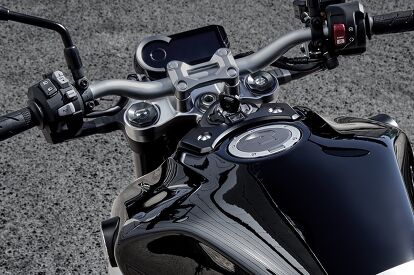


























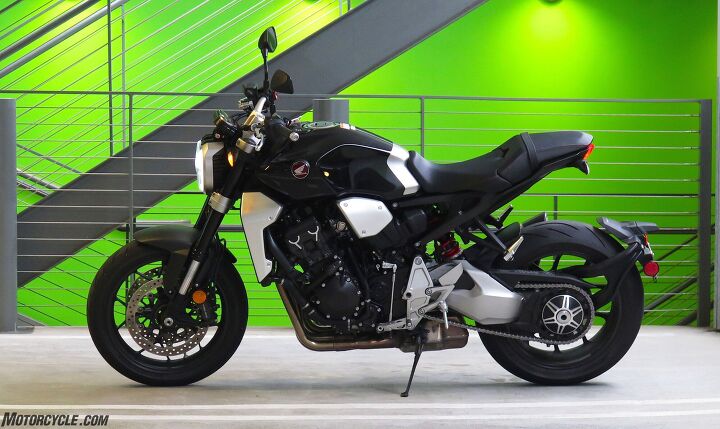




















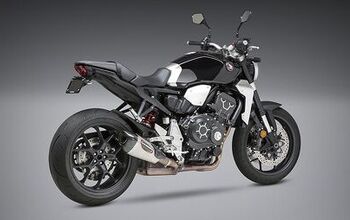
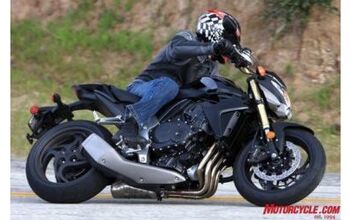
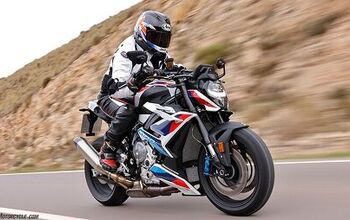













Comments
Join the conversation
I know it's sorta hokey comparing a modified bike (bolt-ons) to a stock bike, but for the real wake up call, get a Z900 for less than 9 grand out the door all-in, bolt an exhaust system on, ECU flash it, and I know by research you get nearly 130 at the wheel, with 73 ft-lb, and from actually owning the Z900 the other year (I go through a lot of bikes), there is no such torque dip anywhere. It's a strong puller without all the waiting for engine momentum.
Glad I bought the GSX-S1000.